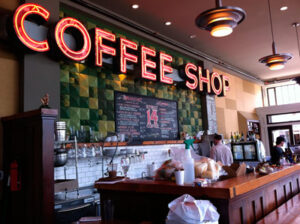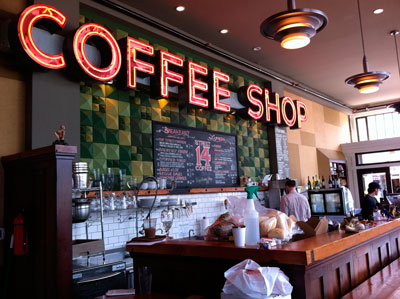If you love the taste of a good cup of coffee, but often think you could make a better one than some of the high-priced chains, then consider learning how to open your own coffee shop. In general, Average coffee shop sales of 250 cups per day are equivalent to a estimated annual income of $ 215,000 or more each year, depending on the cost per cup and your actual location and sales.
According to the 2016 Coffee Statistical Report, coffee shops are rapidly gaining speed with a 20% percent growth rate in specialty coffee sales.
How to open a profitable coffee shop
Find a strategic location
 Options include shopping malls and shopping centers near universities or business centers. Look for features like space in front of the store for sidewalk tables, enough floor space for tables and chairs, cozy seating, couches, and good traffic flow for ordering, picking up coffee, and leaving the store.
Options include shopping malls and shopping centers near universities or business centers. Look for features like space in front of the store for sidewalk tables, enough floor space for tables and chairs, cozy seating, couches, and good traffic flow for ordering, picking up coffee, and leaving the store.
Get licenses and permits
Contact your county board of health to find out how to get a food handling permit. The typical process for obtaining a food handling permit includes passing an inspection, filling out an application, and submitting a fee. Collect state sales tax on the items you sell, so contact the secretary of state and obtain a general sales license that allows you to collect these fees.
Give your company a name
Name your coffee shop something interesting that people will remember. You can use works like “perk”, “brew” or “cup” in the name. Once you have a name, contact a graphic designer in your area. The graphic designer matches the name of your store with a graphic, such as a steamed cup of coffee. Use the logo on business cards, take out mugs, and the sign that goes through the front door.
Buy Equipment and Supplies
Get things like coffee makers, bean grinders, counters, tables, chairs, couches, and armchairs. Look for a coffee blend supplier that sells you in bulk. You will need several different blends of coffee and tea. In addition, purchase metal cups, saucers, and spoons for coffee drinkers at the store, and bring coffee cups, lids, and plastic stirrers to fulfill orders. Remember items like sweeteners, individual cream cups, and napkins.
Get insurance
Find out about the following types of insurance: business property, liability, liability, business auto, if you make deliveries, business crime, and business umbrellas. Both property insurance and liability are required.
Hire employees
Consider how many hours a day the store is open, the busy times that require additional workers, and whether you want to hire full-time or part-time workers. Advertise positions in paper and online job directories, collect applications, interview and choose the best candidates.
The Grand Opening
Send out flyers or coupons to local businesses and invite management for a free tasting. Distribute free samples on the curb in front of your establishment. Send press releases to the media about the grand opening. Have music, free coffee samples, and coupons for future purchases. If people like your coffee, repeat the business and word of mouth is almost certain.
Advice
- Invite local musicians to play during peak hours and announce entertainment.
- Offer wireless Internet as a free benefit to customers.
Do you want to open a coffee shop? Keep in mind the advice of these owners.
The retail value of the coffee market in the United States is around $ 48 billion. But at $ 3 a cup, cashing in on our collective caffeine addiction isn’t always easy. Smart experts share what they have learned.
Maximize Online
“Don’t forget the internet!” Says Lehman. There are many tools that can easily be used to capture additional income by offering your most exclusive products online.
What can an online coffee retailer do? A lot of! Lehman’s site, Crema-coffee.com, sells bean bags, gift certificates, coffee subscriptions, homemade products from respected brands, and even books and travel guides, because coffee can be a lifestyle as much as a drink. .
Listen to your customers
“Define your identity, but adapt,” says Phil Goodlaxson, owner of Corvus Coffee Roasters. “When we started, we just spilled. The morning customers asked for a faster option, so now we also batch prepare. “
Check your accounts
Wondering about sales needs? and the cafeteria expenses. To begin with, Goodlaxson estimates:
- $ 40,000 in equipment
- $ 10,000 in marketing
- 30 to 35 percent of monthly income should go towards monthly operating expenses once it is established.
When considering a location, Goodlaxson uses this metric: within a year or two after your store opens, sales should be 10 times your rent – so if your rent is $ 4,000 a month, you should be selling $ 40,000 dollars. You can not do it? Consider a different place.
Train your employees
Train some of your key people with the education necessary to keep your staff’s skill level high and your beverage quality consistent, “says Jess Steffy, Co-Owner of Square One Coffee, Philadelphia and Lancaster, Pa:
Partner with a roaster that offers a comprehensive barista course for example with an instructor certified by the Coffee Quality Institute.
Learn additional skills with a SCAA Coffee Taster’s Certificate. Learn about green coffee farming, processing, and grading.
Should you roast your own coffee?
It’s the question that many coffee shop owners will eventually contemplate.
Yes do it!
Roasting your own beans gives you more control over the quality of the cup and can ultimately lead to wider margins. All three of our experts toast theirs. Lehman’s main reason: You are able to source coffee from producers you trust. There are many business benefits to this as well, such as branding, “he says.
No, it is not necessary.
If you don’t have any starting capital or previous experience with buying and roasting, it’s best to work with a trusted local or regional roaster, at least to get started. Toasting requires a completely different skill set than running a store and making drinks, ”says Steffy. “Don’t put yourself in a position where your roasting learning curve runs against your store opening time.”

